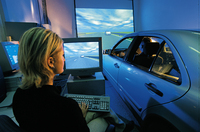Eyes On The Road - User-friendly Onboard Operating Systems
User-friendly onboard operating systems
A human-machine simulator evaluates driver distraction
STUTTGART - March 30, 2007: Just how well onboard controls can be operated is being investigated by the DaimlerChrysler researchers at a very early stage of vehicle development. Using a special simulator to determine whether systems can be easily and intuitively operated, they can thus offer recommendations for interior design at an early stage, thereby reducing costs. For this purpose, the researchers from DaimlerChrysler have developed a human-machine simulator in which a test person is required to carry out a specific task: during a normal drive in a car without critical situations, he or she is called upon to operate a certain system. The demands this places on the test person’s attentiveness can then be evaluated on the basis of objective and subjective criteria.
Measuring and sensing
In addition to deviation from the ideal track, the objective parameters
incorporate data from the gaze monitor, which records how often the driver
diverts his or her attention to the operating system and thus away from the
road. Where appropriate, manual input behavior is also analyzed. These
parameters enable the engineers to calculate the extent of the
driver’s distraction from the traffic.
This evaluation also takes subjective values into account. The candidate’s own assessment of the driving test is determined in the form of an interview involving a catalogue of questions. Depending on the task at hand, various categories and points of emphasis are prescribed. The combination of objective and subjective data ultimately yields a coherent, informative overall picture.
Data acquisition
The tests are carried out by around 20 to 30 selected test persons from
various interest groups and with different driving styles, in order to
determine the degree of operability of a certain function. For this
purpose, in each series of tests several proposed operating modules for a
specific function can be interchanged without excessive technical
effort.
Where appropriate, the investigations are also carried out under genuine driving conditions. In such cases, the researchers use the same vehicle type – but fitted out for normal road traffic operation – as a supplement to the human-machine simulator.
Depending on the task at hand, the scientists from DaimlerChrysler have developed various methods for carrying out both standard and tailor-made tests. For each development phase of a vehicle, they thus have a refined tool at their disposal for obtaining as holistic and verifiable a picture as possible for the operating module in question and for appropriate integration of their findings.



